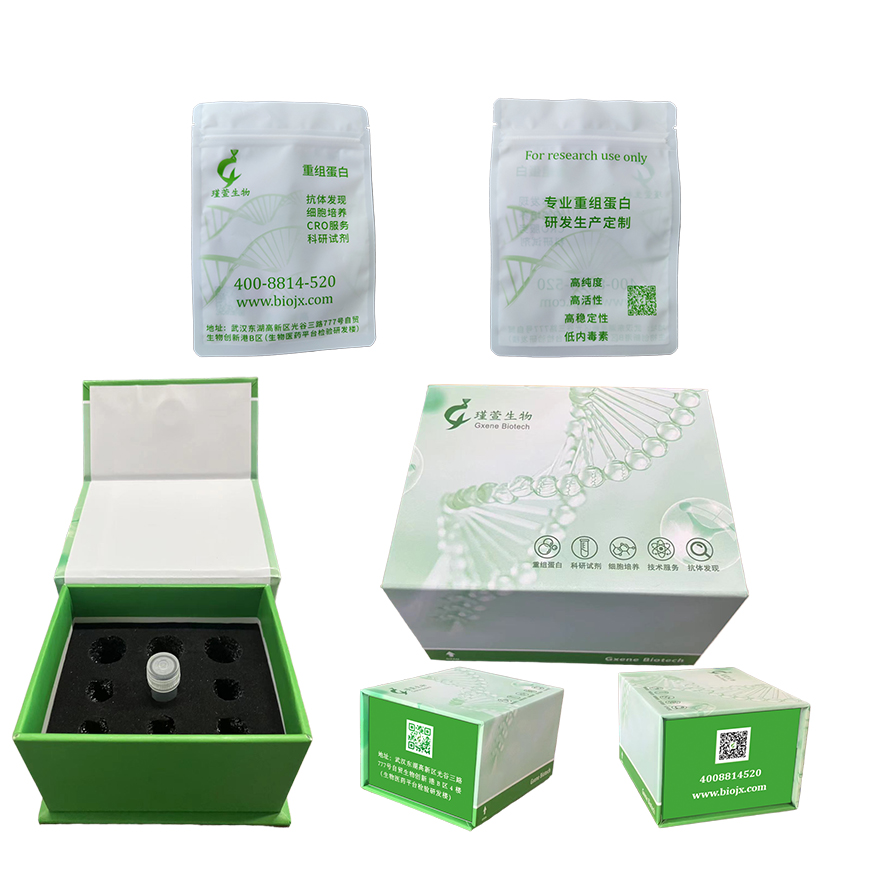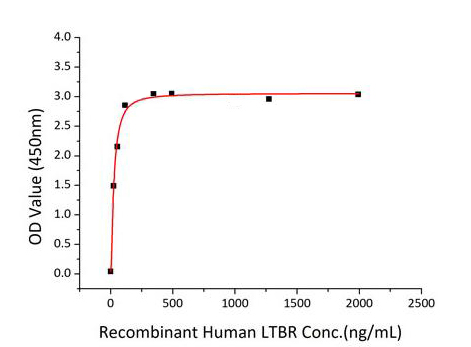种属
Human
表达宿主
HEK293 cells
描述
Recombinant Human TNFRSF3/TNFR-III/LTBR Protein is produced by HEK293 cells expression system. The target protein is expressed with sequence (Gln31-Met227) of human LTBR/TNFRSF3 (Accession #NP_002333.1) fused with an Fc, 6×His tag at the C-terminus.
标签
C-hFc&His
纯度
> 95% by SDS-PAGE.
内毒素
< 0.1 EU/μg of the protein by LAL method.
生物活性
Measured by its binding ability in a functional ELISA. Immobilized Recombinant Human LIGHT at 1 μg/mL (100 μL/well) can bind Recombinant Human LTBR with a linear range of 14.3-57.4 ng/mL.
制剂
Lyophilized from a 0.22 μm filtered solution of PBS, pH 7.4.Contact us for customized product form or formulation.
储存
Store at -20℃.Store the lyophilized protein at -20℃ to -80 ℃ up to 1 year from the date of receipt.
After reconstitution, the protein solution is stable at -20℃ for 3 months, at 2-8℃ for up to 1 week.未开盖的干粉蛋白在 -20°C至-80°C可保存12个月;
复溶之后,蛋白溶液在-20°C及以下可保存3个月,在2-8℃可保存1周。
After reconstitution, the protein solution is stable at -20℃ for 3 months, at 2-8℃ for up to 1 week.未开盖的干粉蛋白在 -20°C至-80°C可保存12个月;
复溶之后,蛋白溶液在-20°C及以下可保存3个月,在2-8℃可保存1周。
复溶
Centrifuge the vial before opening. Reconstitute to a concentration of 0.1-0.5 mg/mL in sterile distilled water. Avoid vortex or vigorously pipetting the protein. For long term storage, it is recommended to add a carrier protein or stablizer (e.g. 0.1% BSA, 5% HSA, 10% FBS or 5% Trehalose), and aliquot the reconstituted protein solution to minimize free-thaw cycles.收到重组蛋白产品之后请检查蛋白冻干粉末是否贴于瓶底,如果粉末浮起,开盖之前请先低温离心。将蛋白用说明书中指定的缓冲液复溶至0.1-0.5 mg/mL(请注意蛋白复溶浓度不能低于0.1 mg/mL),室温平衡5-10 min保证充分溶解,复溶过程中请不要剧烈涡旋及吹打蛋白溶液。如需长期储存,建议复溶时添加载体蛋白或者稳定剂(如0.1% BSA, 5% HSA, 10% FBS 或者 5% 海藻糖),同时将复溶后的蛋白溶液按照需求进行分装,储存于-20°C至-80°C,随取随用,避免反复冻融。
研究方向
淋巴毒素β受体(LTBR),也称为肿瘤坏死因子受体超家族成员3(TNFRSF3),是肿瘤坏死因子受体超家族的成员,也是参与细胞凋亡和细胞因子释放的淋巴毒素的细胞表面受体。LTBR在大多数细胞类型的表面表达,包括乳腺癌、结直肠癌、肺癌、胃癌、黑色素瘤和膀胱癌,而其配体淋巴毒素(LT)a1b2和TNF超家族成员14(TNFSF14;也称为LIGHT)主要是表达于免疫细胞表面。LTBR信号通路可能参与激活控制细胞分化、生长和死亡的反应,如外周淋巴样器官的形成所证明的,特别是对组织、树突状细胞稳态、肝脏再生至关重要的二级和三级淋巴结构。干扰素对病原体的反应和粘膜源性癌的死亡。LTβR 信号传导可能促进浸润免疫细胞和肿瘤细胞之间的通讯。触发 LTβR 会诱导典型和非典型核因子 (NF)-κB 信号通路,这些信号通路与炎症诱导的致癌作用相关。持续的 LTβR 信号传导还会导致 NF-κB 介导的慢性炎症和肝细胞癌 (HCC)。
背景信息



